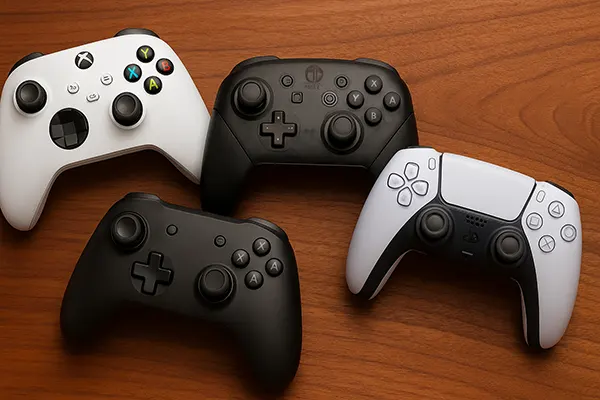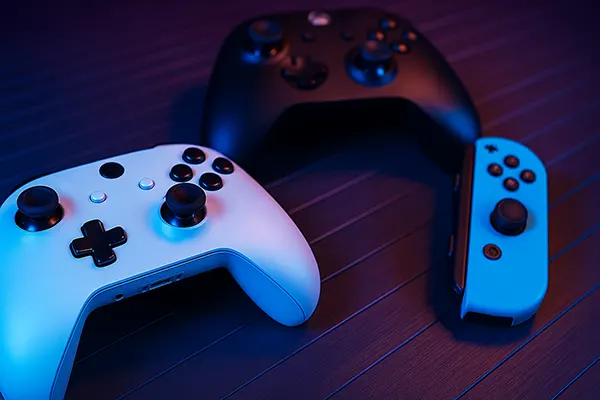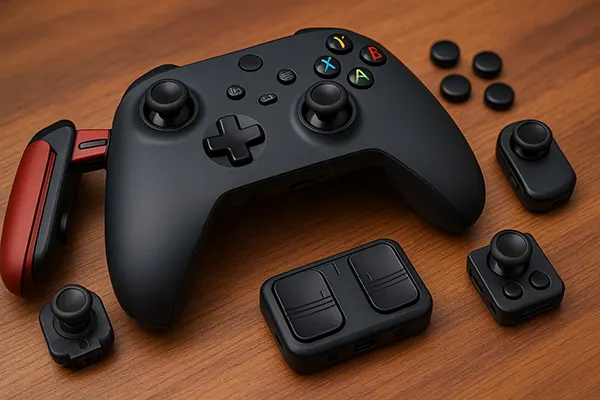
Evolution of PC and Console Controllers in 2024–2025
The past two years have reshaped how players interact with games, as manufacturers refined ergonomics, introduced adaptive systems, and expanded cross-platform compatibility. With more users switching between PC, PlayStation, Xbox and Nintendo devices, controller design has shifted towards universality, lower latency and improved comfort for long sessions. The following overview highlights the most relevant technical and practical advancements that define the current generation of controllers.
Key Releases and Design Improvements in 2024–2025
Manufacturers focused on hardware customisation, broader connectivity and refined shapes that reduce fatigue during extended use. Sony updated DualSense with improved adaptive triggers and quieter haptics, while Microsoft introduced an upgraded Xbox Wireless Controller featuring redesigned bumpers, enhanced grip texture and upgraded low-energy Bluetooth for longer battery life. On the PC market, third-party brands such as 8BitDo, SCUF and Razer launched high-precision models with hall-effect sticks, extended remapping options and metal trigger assemblies for improved durability.
The shift to hall-effect analogue sticks became one of the most notable changes in 2024–2025. These magnetic sensors eliminate physical contact between components, significantly reducing drift issues. As a result, major premium models now feature these sticks by default, raising reliability standards across the industry. Players benefit from smoother input precision, longer component lifespan and fewer calibration problems across Windows, SteamOS and console ecosystems.
Another important update concerns accessibility. Controllers with modular layouts allow users to replace buttons, stick modules or paddles, helping players with mobility challenges to tailor layouts to their needs. Both Microsoft Adaptive Controller updates and new modular kits from third-party manufacturers contributed to more inclusive gaming experiences, offering broader compatibility with PC and consoles.
Technological Shifts Behind Controller Innovation
The most visible technological upgrade is improved wireless performance. Controllers released in 2024–2025 offer reduced latency through Bluetooth Low Energy 5.3, proprietary 2.4 GHz dongles and even USB-C wired modes reaching sub-2 ms input delay. These improvements make controllers suitable for competitive gaming scenarios previously dominated by keyboard-and-mouse setups.
Haptic technology also evolved, with newer vibration motors providing detailed tactile responses. Sony refined the haptic engine inside its updated DualSense, while Nintendo reworked its HD Rumble concept for PC-compatible accessories. Enhanced haptics aim to represent environmental effects more naturally, from recoil feedback to subtle environmental cues, without interfering with overall accuracy.
Software ecosystems expanded as well. Configuration apps for Windows and macOS now support advanced button mapping, stick curve adjustment, trigger sensitivity tweaks and multi-profile storage. These tools allow users to tune controllers to genre-specific requirements, whether they favour racing, shooters, fighting games or exploration-focused titles.
Controller vs Keyboard and Mouse: Practical Comparison
While keyboard-and-mouse setups still dominate precision-based genres such as RTS and competitive shooters, controllers have clear advantages in comfort and analogue movement. Across 2024–2025, developers continued adding full controller support to PC titles, enhancing aim assist settings and improving menu navigation for gamepad users. Many modern games now offer redesigned UI layouts tailored for analogue input.
Controllers provide smooth 360-degree movement, which is important in racing titles, sports simulators and open-world action games. Additionally, their compact form makes them convenient for sofa gaming and portable setups. With handheld PCs gaining popularity, controllers integrate naturally with Steam Deck, ROG Ally and similar devices, supporting seamless transitions between handheld and docked modes.
In contrast, keyboard-and-mouse remains essential for tasks that require quick directional precision or complex input patterns. Many players use hybrid setups depending on genre. The growth of cross-platform gaming has also encouraged developers to balance gameplay mechanics fairly between different input types.
Input Performance and Latency Considerations
Latency is one of the most important factors when choosing a controller. Models released in 2024–2025 often feature wired connection modes offering near-instant response times suitable for competitive play. Proprietary wireless technologies, such as Xbox’s low-latency protocol and 8BitDo’s 2.4 GHz receivers, consistently outperform standard Bluetooth in demanding environments.
Trigger response also improved as manufacturers introduced adjustable trigger stops and pressure-sensitive zones. These options support faster actuation, especially in racing and shooter genres. Modern controllers allow players to tailor trigger resistance and sensitivity directly through software, making them versatile across different game mechanics.
Another performance factor is battery optimisation. Updated energy-efficient chips extend battery life by 20–30% compared to early-generation controllers. Many models offer rechargeable USB-C batteries with fast-charging capability, reducing downtime between sessions and eliminating the need for disposable batteries.

Compatibility, Connectivity and Market Trends
Cross-platform compatibility became a priority for manufacturers during 2024–2025. Most new controllers support multi-device pairing, allowing users to switch between PC, PlayStation, Xbox and mobile devices with a single button. Universal drivers on Windows and Linux simplify setup, while Steam’s controller configuration system recognises a wide range of models and provides native mapping.
Another trend is the rise of professional-grade controllers aimed at esports enthusiasts. These devices offer metal components, swappable sticks, paddles for additional inputs and robust software support. Although they are more expensive than standard models, they provide long-term durability, reduced drift risks and more consistent input responsiveness.
Finally, sustainability plays a growing role in controller design. Manufacturers introduced recycled plastics, modular components for easier repairs and longer-lasting materials in high-wear areas. This approach helps reduce electronic waste and offers gamers products with greater overall lifespan.
How to Choose a Controller in 2025
Users should start by considering compatibility with their primary device. Multi-platform controllers provide flexibility for those who switch between PC and consoles. If competitive performance is important, models with hall-effect sticks, adjustable triggers and low-latency wireless modes offer the most reliable experience.
Comfort is another key factor. Players should pay attention to grip texture, weight distribution and overall ergonomics. Those with larger or smaller hands may prefer designs with adjustable back buttons or customisable stick modules to reduce strain during long sessions.
Technical features also matter. Battery life, charging speed, wireless protocol, software support and build quality influence long-term satisfaction. A well-chosen controller should maintain precise inputs, feel comfortable in the hands and support the games and devices a user interacts with most frequently.
Popular articles
-
 Evolution of PC and Console Controllers in...
Evolution of PC and Console Controllers in...The past two years have reshaped how …
-
 Assassin’s Creed Shadows: A Look at the PC...
Assassin’s Creed Shadows: A Look at the PC...Assassin’s Creed Shadows, the latest entry in …
-
 Modular Game Controllers: Trend or Not?
Modular Game Controllers: Trend or Not?The gaming industry has always been driven …
